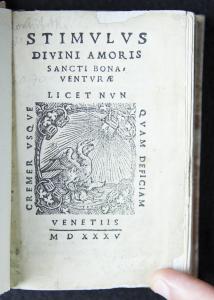

The works in this exhibit are all later versions or publications of titles, authors, or documents that are represented in the Rouse Medieval Manuscript collection. The exhibit content was created by students in a History of the Book seminar in Winter 2014 in the Information Studies Department at UCLA.
Exhibit Home
1. An exact collection of all remonstrances,...
3. Divi Avrelii Avgvstini Hippon. Episcopi...
4. Horae in laudem beatiss[ima] Virginis secu[n]dum....
5. Hore in laudem beatissime Virg[inis] Marie...
6. Les memoires, contenans le discours de plusieurs...
7. Modus Bene Viuendi (Modus Bene Vivendi)
8. Psalteriu[m] v[ir]ginis sanctissime [secundum]...
9. Q. Asco. Pediani In Ciceronis orationes...
10. Quaestiones super XII libros Metaphysicae...
11. Stimulus diuini amoris Sancti Bonauenturae
12. Varii sermoni de Santo Agostino...
13. Varii sermoni di Santo Agostino
Title Stimulus diuini amoris Sancti Bonauenturae

Brief description The Stimulis diuni amoris Sancti Bonaventurae is a devotional work dedicated to the “goad of divine love” (as the title has been translated into English). It is often attributed to Saint Bonaventure but in fact is based on a compilation of works by Jacobus Mediolanensis, another Franciscan scholar, and was completed in the 13th century. [1] The text acts as a manual for mental prayer and meditation on the passion of Christ, and makes an effort to lead the reader towards feelings of compassion and reverence. Printed by Venetian printers Padovano & Ruffinelli in 1535, the Stimulus diuni amoris Sancti Bonaventurae is an example of simple yet quality printing by a small press in Venice. Venice was considered the most important city for print production during this time; by the end of the 15th century there were over 200 presses at work which issued over a million volumes from the time printing was introduced to the city in 1469. [2] This volume makes use of fellow Venetian printer Aldus Manutius’ innovation known as the “octavo,” a small and inexpensive format resembling a pocketbook that would usher in a demand for the distribution of affordable texts meant for personal edification and use. Displaying a concise miniature typeface and showcasing a woodcut printer’s mark of a phoenix rising from flames towards the sun, this volume helps showcase the depth and quality of print culture in Venice during its rise in the 15th and 16th centuries. [1] Richard K. Emerson, ed., Key Figures in Medieval Europe: An Encyclopedia (New York & London: Routledge), 355. [2] Ferdinand Ongania, ed., Early Venetian Printing Illustrated (New York: Charles Scribner and Sons, 1895), 12.
Physical description Binding: This edition has modern cloth binding and marbled paper pasteboards. Printing method: Letterpress; printed in small roman type. Production techniques: Woodcut printer’s device on title page and repeated on verso of last leaf [Padovano’s phoenix rising from the flames towards the sun with its emanating rays].
Content description The Stimulus diuni amoris is a popular devotional work in three parts dedicated to divine love, written by Jacobus Mediolanensis (Jacob of Milan) c. 1280, but formerly attributed to Henri of Beaume (d. 1439), or often Saint Bonaventure (d. 1274), as in this edition. The attribution of the work to Bonaventure has to do with the circulation of the text in conjunction with Bonaventure’s own work, as Jacobus was a contemporary and also a Franciscan lector. Additionally it is thought that unknown persons expanded upon the original work done by Jacobus in the 14th century, rendering its original form ambiguous, thus leading some scholars to believe that it was an “open” text or compilation. The book was intended as a guide to prayer, a devotional meditation on spiritual and divine love and the passion of Christ.
Contributor: Mitchell Erzinger
Contribution date: Winter 2014
Full title: Stimulus diuini amoris Sancti Bonauenturae
Date 1535
Location Venetii
Dimensions 3 1/8 x 4 3/8 [11 cm]
Technologies of production
Additional information According to WorldCat there are 47 editions of this work, with copies in 79 libraries worldwide. The only locatable copy of this Venetiis Italian edition printed by Padovano and Ruffinelli is at UCLA. The work has been translated into several languages: French and Spanish in 1489; Dutch in 1518; Old English in 14th century by Walter Hilton and again in 1642 by B. Lewis Augustine. The print is dominated by text, and its small octavo size suggests portability and regular use. The typeset is mostly uniform with some slanting, which may indicate fast printing. These factors in addition to the variety of translations and publications suggest that the work was probably intended for wide distribution and use. Page numbers 146 to 160 are misprinted; correct numbers are marked in pencil. An edition of the Spanish language edition published by Toulouse Henricus Maier in 1488 has been digitized; a Latin edition published in Cologne in 1505 has also been digitized; a digitized English translation edition from 1907 is also available online as an e-book.
Condition Few markings in pencil [page corrections]; little to no damage, no tears or folds, overall good condition.